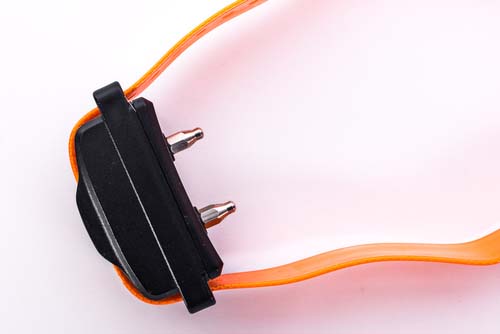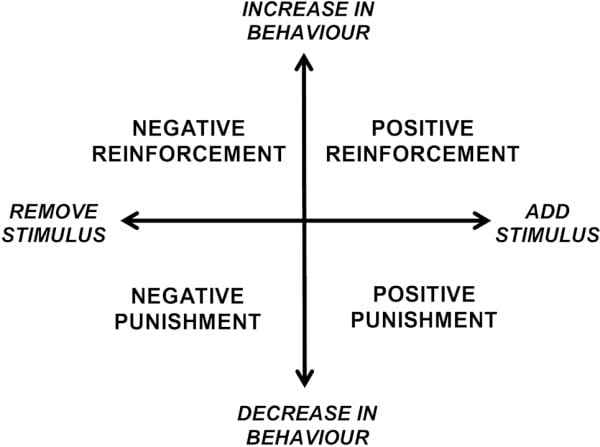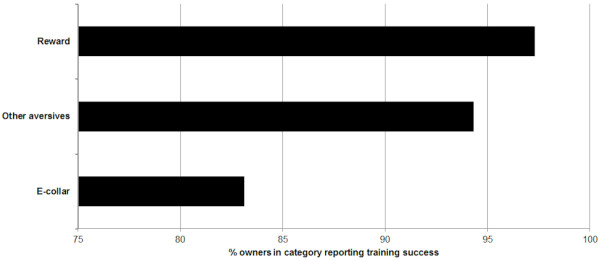In the dog loving community, dog shock collars are controversial. Some owners are completely against using them, others believe there's a time and place for using dog training collars. And some people are still confused whether it's humane to use these devices.  Today we will cover everything you must know about dog shock collars, take a look at science and what makes these devices such a hot-button topic.
Today we will cover everything you must know about dog shock collars, take a look at science and what makes these devices such a hot-button topic.
By now, many people know that electric collars have become a subject of many debates (PDF) on the topic of dog welfare (1), with some studies pointing at undesired effects (PDF) and negative consequences or even their effectiveness (2, 3) with some countries even banning dog shock collars altogether.
The experts' opinion on the use of dog shock collars isn't consistent, however. Whilst some literature is pointing at the side effects of these devices, others argue for them being useful and humane tools (4).
Table of Contents
My goal with this article is to take an objective look at these controversial devices, and analyze the scientific evidence of their effectiveness, negative consequences and how exactly do shock collars work.
The Guide to Dog Shock Collars
What You Absolutely Must Know
What's a dog shock collar, and how does it work?
A shock collar for dogs, also known as electric collars, e-collars, or remote dog training collars, is a device put on a dog that uses a short, small voltage electrical shock (referred to as “stimulation”) to correct behavior in dogs and train them. The electronic collar fits directly against the dog’s neck with conduction points that sit flush against his skin.
The device originated back in 1960s when it was used for training hunting dogs. Original zap collars, as they were called back then, were much more powerful than the ones today. The scientific evidence for their efficacy and safety is still mixed, however.
Obviously, there are pros and cons to using these devices, so let's dig deeper and take a look at what science shows on using shock collars, their advantages and disadvantages.
This is what a dog shock collar looks like:

The conduction points on most electronic training collars provide an electric shock of varying intensity and duration (5). This shock is controlled by pre-settings on the collar or via a remote control that is used by the handler. There are different “stimulation” levels.
Some experts, and in particular Steven R Lindsay in his book “Handbook of Applied Dog Behavior and Training” establishes a few points on how shock dog collars work very well for deterring dogs and are effective for training, because they provide a curb against undesirable behavior in dogs. Think of someone slapping your hand each time you reach for a cookie – you'd learn very quickly not to grab anymore cookies.
Obviously, like most creatures, dogs will seek to avoid negative stimulus (6) and their intelligence allows them to pair specific actions with the initiation of that stimulus. This way the dog learns that in order to avoid the shock, he must not perform a specific undesirable behavior.

A study by Blackwell et al. (7) has analyzed the use of dog training collars and came to the conclusion that, as the above graph shows, dog owners are most often confused or ignorant about the aspects of dog training, including differences between negative and positive punishment, and negative and positive reinforcement, which was observed as the main reason to choose the use of dog shock collars for training.
Key Takeaway: Several studies and experts point at the negative consequences from the use of shock collars. Further research indicates that dog owners are confused about some aspects of dog training and are unaware of the strengths of these devices.
I've thoroughly reviewed Blackwell's study and several accompanying papers, have taken an extensive look at all claimed negative consequences of dog shock collars and whether there's some good scientific evidence on the pros of using dog training collars aside from the arguments made by author Steven R Lindsay.
Moreover, I was very curious to compare these devices to other dog training methods without the use of shock collars – are they more or less effective for correcting behavior in dogs? Here's what I found.
Three Basic Types of Shock Collars
As examined in Lines et al study (5, 8), there are many different dog shock collar models and three basic types: (A-B) the collar that responds to stimulus and (C) the collar that responds to remote activation.
A-B. Stimulus response shock collar
These devices are more specific to certain circumstances, and broken down into two sub-types.
Stimulus-response dog shock collars are almost always used as bark deterrent collars or invisible fence collars. They both work in a similar manner. These dog shock collars initiate a shock automatically in response to a stimulus from the dog. For example, barking or passing through the boundary of an invisible dog containment fence, which is based on pre-settings of the collar.
C. Remote activation shock collar
This is the most popular type of electric collar that dog owners will buy.
Remote activation collars are utilized in more general dog training settings. The electric shock from these remote dog training collars is initiated by the owner or a dog trainer who holds a remote-control device. Shock level and duration is also set by manually pre-setting programs on the remote-control in real time.
The shock, or “stimulation,” of shock collars
Different dog shock collars deliver different levels of shock, and these levels vary drastically.
On average, the strength of an electric shock or “stimuli” from these collars can be anywhere from 7 milliamps (or 0.007 amps) to 1250 milliamps (or 1.25 amps). So what does this mean, exactly?
For reference, 10 milliamps (mA) are enough to cause some pain in humans and animals. Shocks of 50 mA to 75 mA were at the maximum of the individual pain threshold. And 200 mA can be lethal, according to Dartmouth College engineers. With this in mind, it becomes apparent that the “slight shock” delivered by dog shock collars isn’t all that slight after all.
The shock from electric collar will usually last between 1 and 30 seconds (9).
Perhaps what is even more concerning is that many dog shock collars have “volume” dials that allow for the strength of the shock to be increased, in case the handler does not get the desired effect.
Naturally, a dog owner will rarely want to cause pain to the dog. But as indicated in the Blackwell's study, the primary problem is that most dog owners are unaware of the strength of these dog shock collars, and have no idea the pain a certain level of shock may deliver to the dog, or by how much they are increasing the strength when turning it up and what the delivered shock actually does to the dog (10).
Finally, since dog owners have no idea how strong a shock collar is or what that shock feels like, they have no way of determining if or when the dog shock collar malfunctions.
Do Shock Collars Really Work?
 On the surface, it may seem that dog shock collars can be a rather effective dog training tool if we ignore the controversial part of potentially causing pain and other discomfort for the dog. After all, they get the dog to stop performing undesirable behavior, or at least that's what the owners' consensus is.
On the surface, it may seem that dog shock collars can be a rather effective dog training tool if we ignore the controversial part of potentially causing pain and other discomfort for the dog. After all, they get the dog to stop performing undesirable behavior, or at least that's what the owners' consensus is.
Advocates of these devices claim that shock collars are the most effective way to fix self-rewarding behavioral problems in dogs, and they also claim that the use of electric collars causes less damage to dog's long-term welfare as compared to other “punishment dog training” methods. It's important to note that there are several types of dog training collars, too.
I've spent several days going through different scientific papers to find evidence of the efficacy of dog training collars. And while there is some evidence to the use of dog training collars as part of an official “program” of training among police and hunting dogs (11, 12), these do not apply to casual owners.
Overall, there is no conclusive evidence to the effectiveness of dog training collars.
Moreover, another big study (13) conducted by Cooper et al. on the welfare of dogs and the use of e-collars has found a clear risk the use of dog shock collars presents. In particular, the study observed that dogs trained with e-collars had more signs of behavioral distress.
The similar problems were observed when shock collars were used in accordance with the manufacturer's guidelines, meaning that even dog owners who know how to use shock collars properly cannot avoid the disadvantages of these devices. This was proven by measuring stress hormone cortisol levels in dogs, which is the most effective way to understand distress in canines (14, 15).
Key Takeaway: Dog shock collars are popular to use with police, hunting and herding dogs. However, there's no conclusive evidence of their effectiveness as compared to other training methods. Also, proper use of shock collars still causes distress in dogs.
Other dog training methods vs shock collars
With the above in mind, it's important to take a look whether other dog training methods and techniques are more effective than the use of dog shock collars. The British Veterinary Behaviour Association has claimed that reward based training methods produce better results than the use of e-collars and any other “negative” type of dog training (16). Zazie Todd, PhD has done a review of this paper here.
However, there is no evidence that this is the case. In fact, it appears that negative punishment and negative reinforcement techniques were effective for correcting behavioral problems in dogs, particularly when used alongside positive reinforcement (17).
Going back to the Blackwell's study, there was a survey of dog owners on the efficacy of dog training techniques. Dog owners reported that humane dog training methods are more effective than those that call for the use of shock collars (7, 18, 19). Dog owners also reported that citronella collars were more effective than electronic bark collars as a way to correct specific behavior in dogs (20).

Obviously, it's possible that the perception of a training method could've influenced dog owners' opinion and view of the efficacy of training methods.
In conclusion, there doesn't seem to be any good study that would clearly compare the use of dog training collars alongside the use of positive reinforcement and punishment dog training methodology.
It is clear, however, that there are negative consequences to the use of dog shock collars, which could be a good enough reason to stop using them and instead switch to alternative dog training methods.
Key Takeaway: There is no clear evidence which dog training method is superior. However, there's proof that dog shock collars cause distress in canines, which is a good enough reason to use alternative methods. More research is needed in this area.
Owners' Perception of Dog Shock Collar Training
Plenty of dog trainers, owners and other canine experts have publicly demonized the use of dog shock collars and brought up some great points. Using electric dog collars for training has its consequences, which we have explored above.
However, while there is no scientific evidence to support most of the claims made on either side of the argument, knowing that dog e-collars cause distress in pet dogs may be enough to seek alternative methods.
Here are their main arguments:
1. I Can’t Trust You
When you pinch the child for mispronunciation, you are teaching him that he can’t trust you not to hurt him. A healthy relationship depends on trust. If that trust is never built or is broken, it creates a poor foundation for a relationship.
2. I Still Don’t Know What You Want from Me…
When you pinch the child, you are deterring him from mispronunciation, but you are failing to give him the correct pronunciation. Expecting anyone to know how to do something correctly by punishing them for doing it incorrectly is nonsensical and unproductive.
3. I’m Not Going to Try Anymore
Negative reinforcement can cause trepidation. If every time a child mispronounces a word, they are pinched, they are going to be hesitant to try pronouncing any new word in case they mispronounce it.
To create a desire for learning and willingness to try new tasks, it is important to avoid punishing attempts to learn (even when the attempt is incorrect).
4. I’m Not Going to Attempt Similar Tasks to the Discouraged Task
When the child in our example is punished for mispronouncing a word (for example pronouncing “wine” as “win-e”) they are less likely to attempt pronunciation of similar words (for example, “wide”).
While the child may not know how to pronounce either word, they can recognize the pattern of the word and associate that pattern with being punished.
Negative reinforcement may be effective, but it is not efficient. When using a shock collar during training, you are “pinching your child” and creating a lack of trust, confusion, reluctance, and discouragement.
If Not a Shock Collar, Then What?
If dog shock collars would prove to be effective in any future research, they clearly do not facilitate a healthy relationship with your pet or create a willingness to learn. This is because dogs, like humans, will learn from negative reinforcement, but that learning is driven by a desire to avoid pain.
This leaves us with a need for positive reinforcement. Positive reinforcement teaches your dog when a behavior is desirable without the undesirable side effects that come with negative reinforcement.
Let’s go back to our example of the child reading and switch the negative reinforcement to positive.
When the child mispronounces the word “wine” as “win-e”, you refrain from pinching him, but demonstrate how the word should be pronounced. Then, you ask the child to try again. He tries again and this time pronounces the word correctly. You praise him for his effort and success.
In this example, you are no longer breaking down the child for failing, rather you are praising him for succeeding. This creates a willingness to try, a confidence in their ability, and a trust that you can (and will) show him what is desired of him.
How does this apply to your dog?
Positive reinforcement (such as training treats, praise, belly rubs) creates a stronger and more trusting relationship. It directs your dog in how to behave rather than how not to behave.
Common Myths About the Use of Dog Shock Collars
 The biggest reason that there is so much controversy surrounding the use of dog shock collars is because there is so much misinformation out there. If you're going to use a training tool with your dog, especially something as controversial as a shock collar, you need to be a responsible dog owner and do your research.
The biggest reason that there is so much controversy surrounding the use of dog shock collars is because there is so much misinformation out there. If you're going to use a training tool with your dog, especially something as controversial as a shock collar, you need to be a responsible dog owner and do your research.
Here are 5 of the most commonly believed myths about dog shock collars:
1. Just a couple of shocks is all it takes, so it’s not really a negative training method
Proponents of shock collars say that it only takes a couple of shocks and a dog has learned what is expected of them. While this may be true, those couple of shocks are all it takes for a dog to make a connection between you, pain, and what they are being asked to do. You may not be using a shock to compel your dog to comply with commands in the future, but he still recalls that pain and complies with you out of fear.
2. Dogs learn faster when shock collars are used
Shock collars may seem like they are teaching your dog at a faster pace, but what are they teaching? They certainly don’t teach a dog what is expected of him. Instead, they are teaching the dog that when he does something you dislike, he will experience pain.
This is not training – it's aversion.
A dog will avoid what causes him pain because it hurts him, not because he has learned that it is not a desirable behavior. This goes back to the myth above. He's not learning to stop doing the unwanted behavior. You're teaching him that you will hurt him, and you cannot be trusted.
3. Shock collars can be the right tool for some dogs
Some proponents of the shock collar will say that it can be the right tool for training some dogs. These dogs are usually referred to as being “hard-headed” or “stubborn”. The fact of the matter is that these dogs can be trained using other means; the trainer simply isn’t working to find out what those means are.
Every dog can be trained without a shock collar. It is only lazy trainers who fail to find a good source of motivation and that want “fast results” who believe that dog shock collars are the only training solution.
4. If shock collars were so bad, they wouldn’t be sold
Some advocate dog shock collars by claiming that if they were “so bad” they wouldn’t be allowed to be sold.
It is important to know what the word “bad” refers to, however. When proponents of these collars use the word “bad” they refer to the shock that the collar delivers. They believe that the strength of the shock from the collar is not enough to cause significant harm.
Even if the shock that these collars deliver isn’t enough to cause significant physical harm, it is enough to create a negative experience. This negative association of pain with you and with training in general is “bad,” because it teaches your dog to be afraid of you and to expect pain to be a part of training in the future.
5. Only bad dog owners use shock collars
While shock collars may or may not be a beneficial tool for training a dog, it is important to know that using a shock collar does not automatically make a dog owner a “bad person”. Many dog owners use training tools because they see other dog owners using them or because they are told that they are effective tools to use.
As the Blackwell study reported, there is a small percentage of dog owners who actually use dog shock collars and most owners rely on other training methods. Moreover, it seems that most dog owners sincerely believe in the safety and efficacy of these dog training devices, especially when they are so commonly used with police and hunting dogs.
READ NEXT: Dog Shock Collar Controversy – What Do The Experts Say?
References
READ NEXT: No More Pain – Best Alternatives to Shock Collars for Dogs



